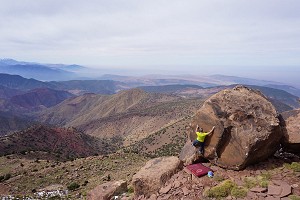
A Taste of Africa - by Emma Alsford. All photos by Emma Alsford unless otherwise credited
When I met two American girls in El Chorro, Spain, it seemed easy to slip into that end of the day chat with a couple of like minded strangers at the crag. I could tell straight away that they were competent climbers, and obviously super keen too, it was something about the way they flowed on the rock, merrily chatting their way through each crux.
For us Brits, El Chorro is an easy winter break, a few hours after closing the front door in the rain, you can be heaving your over indulgent Christmas arse up sun kissed limestone, with all kinds of inflated hopes and dreams for the climbing year ahead. But America seems a fair bit further away, and I said so, being somewhat impressed at these fresh faced young girl's efforts.
'So how long are you here..a week? Wow, that's a long way to come..'
'Well, it's kinda not too bad..we've been to Morocco first..'
'Ah..to the Todra Gorge I expect?' I went on rather knowingly, as I feel like a bit of a Moroccan expert, having been new routing in an area most climbers haven't even heard of for the last five years.
'Well no..' they replied. 'It was a little cold in the High Atlas so we based ourselves in an area near Tafraoute..'
It was clear these young girls knew their stuff when it came to climbing in Morocco, and I was momentarily stumped. Now don't get me wrong, I really am not the least bit sexist (well, I like to think so anyway), but I simply don't meet many other women (or any other climbers for that matter) who climb in this region of Morocco. Up until now there has been limited information on the place and the main game is rather adventurous new routing. I started to become rather impressed.
You didn't travel around to the north side..near Idaougnidif..where the Kasbah Tizourgane is..?'
Apparently they had, and as the conversation went on, it not only transpired that these fresh faced youths had climbed in Morocco, but they had explored an area very little known about, and even climbed some new routes! What a small world the climbing community can be.
Development of the Anti-Atlas
The Anti-Atlas region of Morocco occupies a significant proportion of the country to the south and east of the Atlantic coast holiday resort of Agadir. It is a mountainous, semi-desert region, bounded on the north side by the Oued Sous valley, beyond which lies the High Atlas and the famous city of Marrakech. The oasis town of Tafraoute is situated approximately in the centre of the Anti-Atlas, some 200km south of Marrakech, and 150km south-east of Agadir. It lies at an altitude of 900m. This is the best base for climbing on the south (sunny) side of Jebel El Kest, and it takes about 2hrs by car from Agadir. For climbing on the north side of Jebel El Kest, it is best to base yourself at the Kasbah Tizourgane by the town of Idaougnidif (approx. 1hr and ½ from Agadir). This has been converted beautifully from an old fortified granary by the present owners, Jamal and Malika, who run an extremely welcoming and hospitable establishment, and are extremely helpful about any aspect of your stay.
The rock around these parts is a type of quartzite, predominantly very solid, and the routes vary from single pitch to multi pitches of up to ten or fifteen long. The approaches range from walk ins of five minutes up to one and a half hours, and descents can also vary, from one hour walk offs to a quick abseil descent and back to the car by the time your second has packed their sack. There is pretty much guaranteed sunshine from September through to April (May to August would probably be too hot), although rain can occur in December and January, when nights can also be a bit chilly. Suffice to say I have visited the area ten times already during January, March, April, October and December, and only experienced a couple of rainy days. There is also a choice of north and south facing crags, to accommodate all preferences and provide perfect climbing temperatures.
The sunnier south side of the Jebel El Kest massif, based very close to Tafraoute, was first discovered by Les Brown and the late Trevor Jones, whilst on a family holiday in 1991. They returned on and off over the years with a keen crew including the likes of Joe Brown, Chris Bonnington and Claude Davies, who wrote a very informative but no frills guide called Climbing In The Moroccan Anti Atlas (Cicerone Guide) in 2003.
During this period of development, which produced over 160 routes, one of the most impressive and noteworthy ascents was Jim Fotheringham, Ben Wintringham and Derek Walker's The Sword of Allah (climbed after the production of Claude's guidebook), not least because it can be seen as a very impressive and distinctive feature from the approach road to Tafraoute, and is probably the most eye catching line in the area. This route is five pitches long, graded British E3 6a, took the team more than one attempt to complete, and only after the introduction of a Camelot 6!
There are several choices for accommodation in Tafraoute, ranging from the grand hotel Les Amandiers high on the hillside (with en suites and a swimming pool, a bargain at roughly £30 a night for full board), to cheaper hostels and even camping.
The north side of Jebel el Kest is where most of the action is occurring at the moment, and all the information can be found at www.moroccorock.com where you can also purchase the brand new guidebook by Crack Addicts publications called Morocco Rock. This is where I began climbing in 2007 with my partner Paul as there were plenty of stunning new routes to go at and the rock was generally solid and varied.
A Sample of Routes on the North Side of Jebel El Kest
One of the best crags in the area has to be Adrar Umlil, or The White Dome, as it is commonly referred to, situated close to Idaougnidif,. It has superb rock quality throughout, on all of its five towers, and route lengths vary up to four pitches. And not so long ago, despite thinking these crags were almost 'climbed out', Paul and I found yet another superb and exciting line. I had been eyeing it up since the trip the previous year, as I am a bit of a chimney magnet, and I love any climbs that involve a bit of character building bridging, squeezing or even off-width chicken winging! This immense goliath of a feature had it all, a real fight, and it left us both with a fair amount of battle scars – we called it Giant (E2), as this tower has a movie theme going on, with Some Like It Hot (E3) and Leaving Las Vegas (E2) already established classics. Though for a slightly more amenable line, the classic Jaws (E1) is a must. For more immaculate rock the very nearby Adrar Iffran has a truly impressive and inspiring wall of golden quartzite – North Gully Wall – the best two routes here have to be Em's Cleft (needs no explanation) (HVS 5a) and The Mighty Logan (E4 5c) for a harder testpiece to test your technique and nerve.
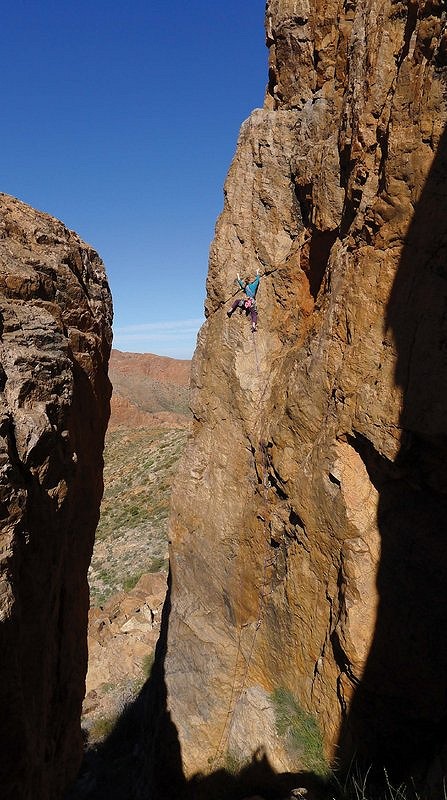
Another popular crag is Lower Eagle, and for good reason. The rock is the same hard baked and solid quartzite, and the routes are usually up to six pitches long, yet the walk in is fifteen minutes, practically a roadside crag! My favourite here is Black Beauty (E1), which follows the photogenic black streak running the full height of the cliff. It is the route we christened this cliff with, on our first ever visit to Morocco. The route very obviously follows a well-worn water line, and after heavy rain the second pitch can feel a little mossy, but this doesn't detract from the sheer quality of climbing throughout, and like the other routes on this cliff, it feels like a really big adventure. The fourth pitch breaks out rightwards from a main corner feature due to a resident in situ tree, and tackles some intimidating bulges. However, they succumb at a surprisingly amenable standard and add to the varied nature of climbing on the line. Further right, and on a different trip, we discovered Infinity (E4), which is still my hardest on site lead to date in Morocco. The first two pitches contain the best climbing moves I have done anywhere. It feels a little bold straight off the ground, but soon a striking steep flake crack soars above the main break, with only just ample holds to get you through the crux, and big cams fast becoming your closest friends! For a more amenable line, the route Pink Lady (VS) is fast gaining a reputation for being a delightful mountaineering excursion.
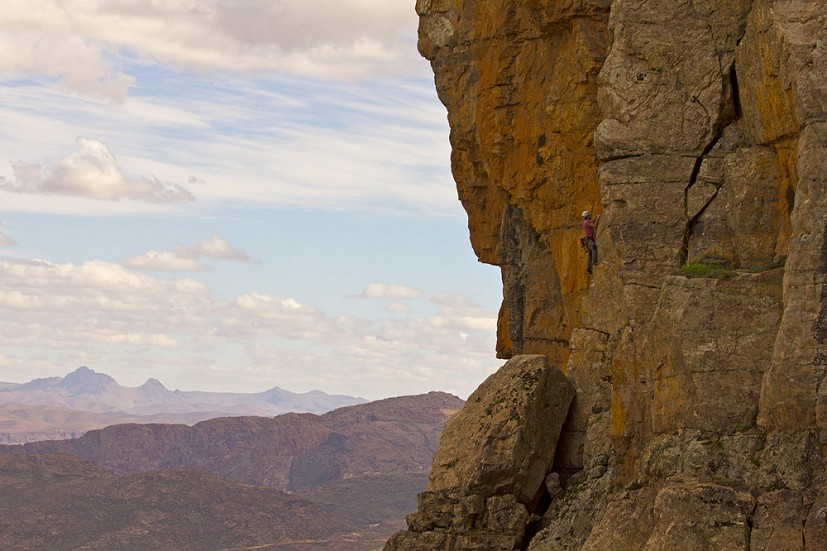
There are also a couple of roadside crags which are useful venues for semi rest days when long walk ins are not such an attractive proposition – Griffon Rock, Ksar Rock and The Narrow Slit are good examples of these, the latter which can be found in the new guide under the Tizi Escarpment. These generally single pitch crags are both a couple of minutes from the road and have a variety of grades ranging from Severe to E5. My favourites at Griffon Rock are Crackerjack (E3) and Grasshopper Arete (VS) and the bonus is that this crag faces north and south, giving plenty of options for sunny or shady climbing, depending on what the weather dictates. At The Narrow Slit my top two picks would be Pythagosaurus (HVS), a tremendous corner feature, and the test piece Amphibian (E4).
Another crag well worth a visit is near Imrir on the Tizi escarpment. The information for this set of buttresses can again be found in the new guide. The approach is up a steep hillside above the village and takes about thirty minutes, and route lengths range from one to four pitches. Cracktastic (E1), Titan's Chimney (E1), Butch Cassidy (VS) Sundance (E2) and Cosmic Corner (E3) are all well worth seeking out. It's not unusual here to be warmly greeted by the locals, who seem to take a keen interest in the bizarre antics of the foreigners occupying their local rocks! But for more adventurous outings a 'must see' cliff is the huge dome of Assldrar, nick named by locals 'The Thumb' which is self explanatory when you first catch sight of it towering above the tiny settlement below. This venue is host to a number of 8 pitch outings on superb rock with great lines – Adventures Beyond the Ultraworld (E5), Rhythm and Stealth (E3) Orgasmatron (E3), Sungold (E2) and Assldrar Welcome (VS) are all raved about.
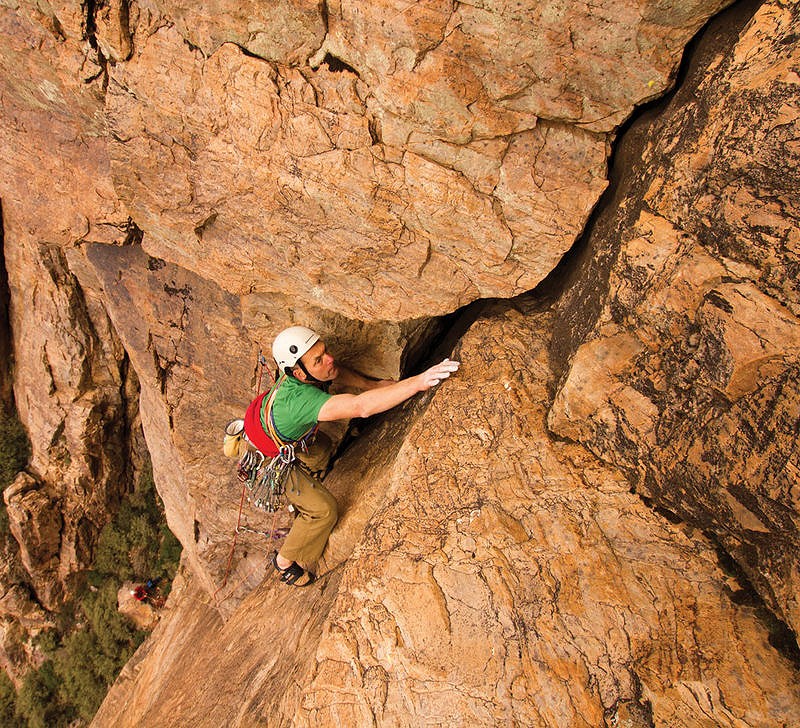
One tick which is an absolute must is the route Tusker (S) on The Boar's Pinnacle. It climbs a most unusual, free standing (and huge) pinnacle, about thirty metres high, and the snowy covered High Atlas is nearly always visible in the background – a little quirky gem and quite clearly a very photogenic route! The surrounding area is extremely picturesque and it is the ideal picnic spot, situated high up on a hillside and surrounded by pretty terraces. It can also usually be seen from the Kasbah, on a clear day and if you look hard enough!
The Samazar Valley is one of the most lush areas around, for this semi arid environment, and there are plenty of adventurous undertakings here, such as the routes on Valhalla Wall behind the Flat Iron or the long outings to be found up the majestic Waterfall Walls. However it is worth also seeking out the less obvious Icebox Canyon (approached far more quickly from the Afantinzar Valley), with its plethora of tasty steep wall climbs, and also the more recently developed Dragon Buttress (quite hidden from the Samazar Valley approach track but only a ten minute walk from the car), where the stunning Firesword (E1) and Shruikan (E2) are not to be missed. on a trip to Morocco – they are two of the best routes I have done anywhere.
There are many other worthwhile areas to visit, and development here is expanding at a rate of knots. At present there are well over 1,000 routes on the north side, with plenty of new routes to go at, if that's your thing.
The Culture
Morocco has been the home of the Berbers since the second millennium B.C, although they have predominantly had secondary status since the Arabs invaded circa 685, when Islam was introduced to the country. In 1660, Morocco came under the control of the Alawite dynasty (descended from the prophet Muhammad), which rules to this day. European powers showed interest in colonising Morocco from 1840, resulting in France controlling almost all of Morocco, except a small southwest portion, which became known as the Spanish Sahara. France and Spain only recognised the independency and sovereignty of the country in 1956. In August 1999, King Hassan II died after 38 years on the throne and was succeeded by his son, Prince Sidi Muhammed. Since then the crowned King Muhammed VI has pledged to make the political system more open, allow freedom of expression, support economic reform and advocated more rights for women. With about 20% of the population living in dire poverty, economic expansion is a primary goal.
Because of this convoluted history, Morocco is a country of multi-ethnic groups with a rich culture and civilisation. The official languages spoken are Arabic and French, although Berber is often dominant in the more rural areas. It has conceived many forms of beliefs, from Paganism, Judaism, Christianity and Islam, though the Muslim religion tends to dominate today, with prayers ringing out from the mosques several times a day. Each region possesses its own uniqueness and a priority in Morocco is the protection of its diversity and the preservation of its cultural heritage. The locals are extremely friendly, though it is worth noting that the women can still often cover up with their djellabas (or burkha), especially in the rural areas, and particularly when westerners approach, so it is worth having a somewhat diplomatic approach and dressing rather tactfully.
Logistics
Flights can be obtained predominantly from Manchester or Gatwick.
The local currency is the Dirham (roughly 13 to the Pound Sterling), best obtained at the airport, as it is difficult to obtain them outside the country (and more expensive - bear in mind that it is an offence to take any currency out of Morocco).
Car hire is a must, to get around, and this can be done from the airport in Agadir – First Car always give us very good service, and if you mention Emma and Paul, they will probably give you a good deal too!
For the North Side of Jebel el Kest and Jebel Taskra it is best to stay at the Kasbah Tizourgane – contact Jamal and Malika, all details in the new guide. It is also possible to stay in Tafraoute (more choices) but this adds about an hour and a half onto the days climbing.
It is worth noting that the nearest hospital is at Agadir, and there are no helicopter rescue services. As there are no local rescue facilities, it is worth exercising some extra caution when climbing (and minimal risk taking!), as any accidents could prove problematic to say the least.
Also, being a muslim country, alcohol is not available everywhere, so its worth stocking up in Agadir if you feel you cannot do without! (The hotel Amandiers serves alcohol but the Kasbah Tizourgane does not - so take your own).
Lastly, and regarding gear – it is always worth taking plenty of cams, spare tat for abseils, and an oversized rather than undersized rack (no climbing shops). Also 60m ropes are preferable.
Accommodation Advertise here
No Premier Listings found in this area
Instructor/Guides Advertise here
No Premier Listings found in this area
Outdoor Shops Advertise here
No Premier Listings found in this area
About the Authors
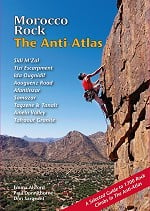
They were introduced to the rock climbing in the Anti Atlas region and specifically the Jebel el Kest and Taskra ranges by Ben and Marion Wintringham. Ben began documenting and recording the new climbs in the region when the 'explosion' of activity began on the north side of Jebel el Kest and Jebel Taskra, in 2007.
Emma and Paul have taken over the work which Ben began on recording new routes in the area since his tragic death in October 2011. Ben felt passionate about the Moroccan Anti Atlas and the Jebel el Kest massif and his enthusiasm for the area lives on in the legacy he helped to create for the enjoyment of trad climbing adventure in the winter sun.
Morocco Rock is Emma and Paul's first self published guidebook, and it documents all the climbing in this Anti-Atlas region to date – approximately 1,000 routes on over 100 crags in the Jebel el Kest and Jebel Taskra massifs – from single pitch up to 800 metres in length, with approaches varying from 2 minutes to an hour. For more information and to purchase the guidebook go to www.moroccorock.com.
Watch a video of climbing in Morocco below by Bald Eagle Productions

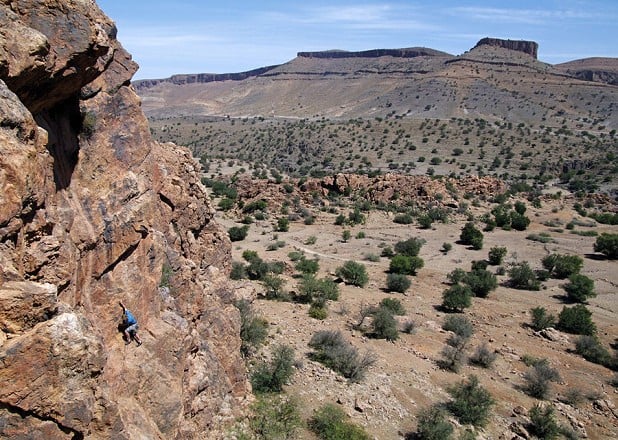
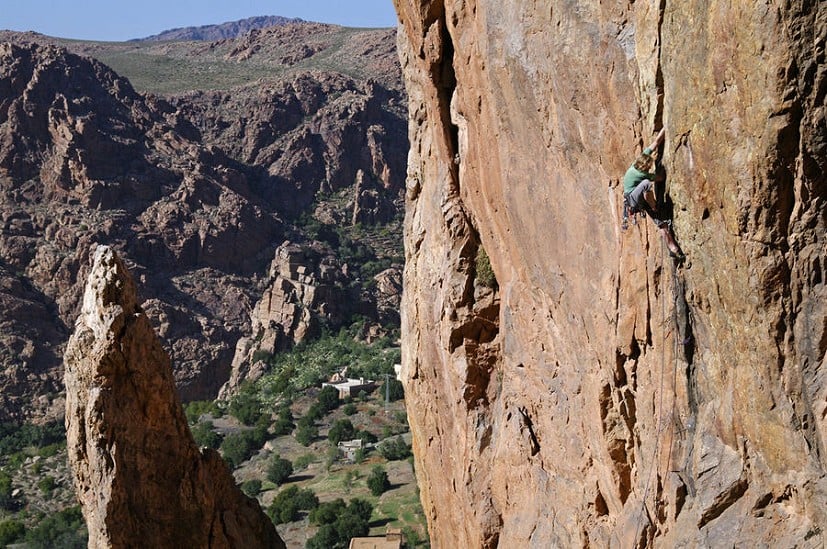
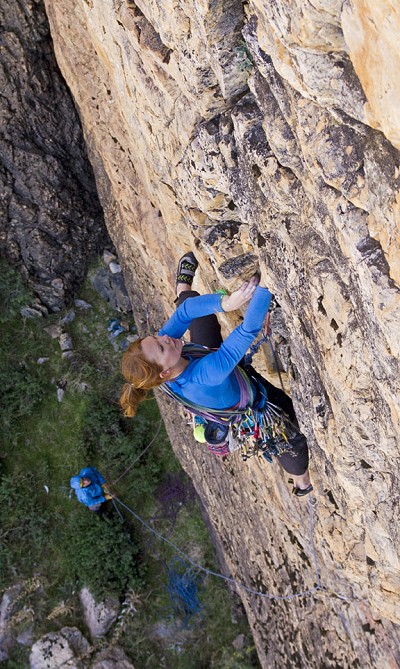
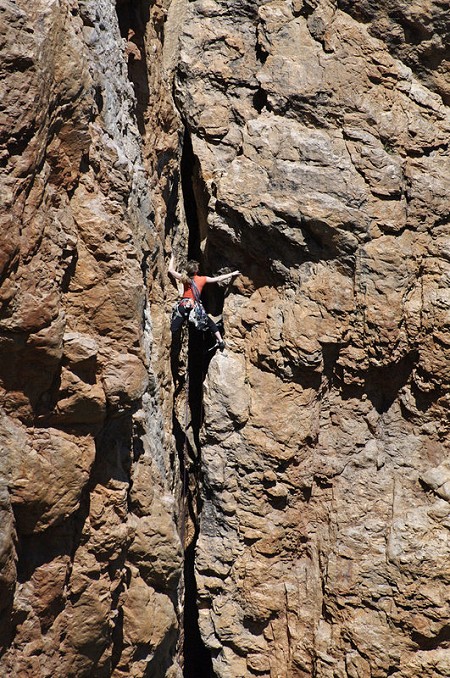
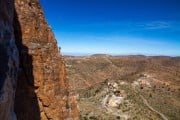
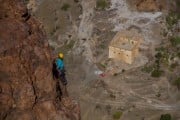



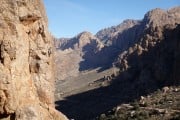



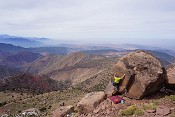
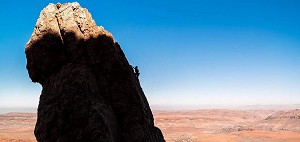

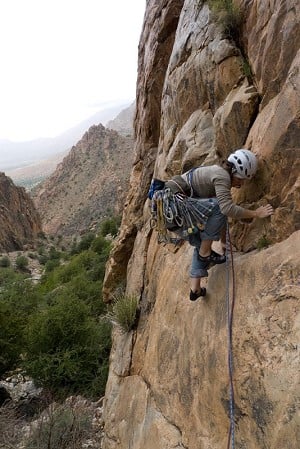
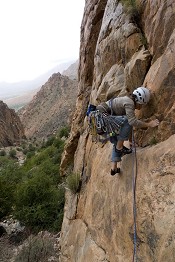



Comments